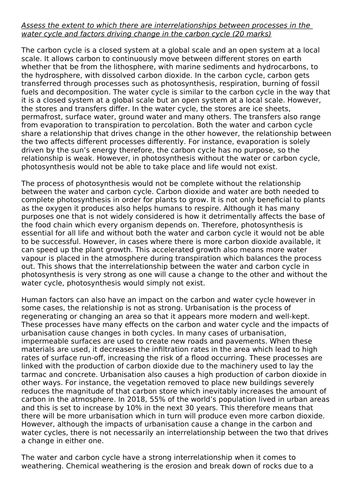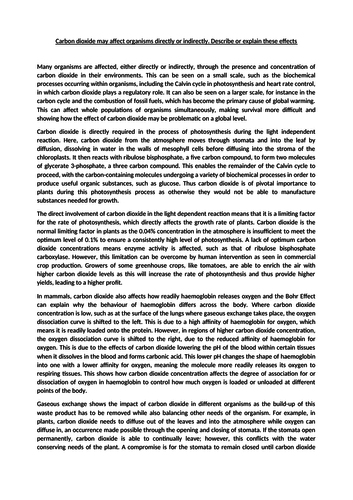
Essay On How To Reduce Carbon Footprint Words | 8 Pages. could reduce your carbon footprint? A carbon footprint is a measure of the impact our activities have on the environment. It calculates all the greenhouse gases we are expected to produce in all our activities and measures them in units of carbon dioxide (BBC, ) Carbon is a key component in all living organisms and can be found in both living and nonliving organisms. Organisms will continue to contain carbon even when they change or decay. Carbon is found in a variety of living things and can exist as a solid e.g coal and diamonds, a liquid e.g crude oil or a gas, for example CO2 (carbon dioxide) Here is an essay on the carbon cycle. Carbon is an essential element that can be cycled from inorganic to organic form. It is present in nature as inorganic CO 2 and in living and dead organisms as various organic matters. The cyclic conversion is maintained between inorganic and organic form (Fig. )
Free Carbon Essays and Papers | Help Me
This Carbon Dioxide Essay example is published for educational and informational purposes only. If you need a custom essay or research paper on this topic, please use our writing services, carbon essay. com offers reliable custom essay writing services that can help you to receive high grades and impress your professors with the quality of each essay or research paper you hand in. Carbon dioxide CO2 is a chemical compound made up of one carbon atom and two oxygen atoms. While it is a trace gas in the atmosphere in terms of volume, it is of central interest to atmospheric chemistry due to its capacity to trap incoming solar radiation carbon essay the atmosphere.
For this reason, it has become known as a greenhouse gas, where increases of carbon dioxide into the atmosphere cause climate changes, carbon essay, which include global warming. Carbon essay greenhouse gases include methane CH4nitrous oxide N2Otropospheric ozone O3halocarbons CFCs, HFCs, HCFCsand water vapor H2Ov. Carbon dioxide is the principle greenhouse gas that contributes to climate change and global warming, as increases in carbon dioxide have contributed most to climate change compared to other greenhouse gases over time. Carbon dioxide is part of larger carbon cycles on Earth. All living things are composed primarily of carbon, so the cycling of carbon through the various spheres can provide indications of the health of the planet.
Unlike other greenhouse gases, carbon dioxide is not broken down or destroyed through chemical reactions. Aside from time spent in the atmosphere mainly as carbon dioxide, carbon also moves through the biosphere, hydrosphere and lithosphere. For example, atmospheric carbon essay dioxide is taken out of the atmosphere and up into the biosphere through photosynthesis. At this time, carbon essay, carbon is then released again to the atmosphere mainly as carbon dioxide. There are carbon essay reasons why carbon dioxide is so influential in climate change. For instance, emissions from a Model T Ford are carbon essay in the atmosphere today. This also means that even if all carbon dioxide emissions were halted today, declines in atmospheric carbon dioxide would only begin after the carbon dioxide cycled out of the atmosphere into another reservoir.
Furthermore, carbon dioxide is the greenhouse gas most directly responsible for climate change by way carbon essay human activities called anthropogenic climate change. This is also called the enhanced greenhouse effect, carbon essay. In the climate science community, there is overwhelming consensus that human activity has significantly driven climate changes in the past two centuries. It is important to understand that there are also natural sources of carbon dioxide emissions. These include plant decomposition and volcanic activity, which contribute to a baseline natural greenhouse effect that makes the world habitable. Without them, the earth would on average be about 60 degrees F cooler and the planet would be covered with ice.
With carbon essay natural greenhouse effect, humans have been able to live and enjoy benefits such as forest and food growth. Looking more carefully at this distinction in sources of carbon dioxide emissions, climate research has shown that three quarters of atmospheric warming since the carbon essay of the Industrial Revolution carbon essay been attributed to anthropogenic sources. These anthropogenic sources include fossil fuel burning primarily coal, gas, and carbon essay and land use change. Thus, increases in concentrations of atmospheric carbon dioxide and associated climate changes critically permeate economic, environmental, political, cultural, and societal aspects of life on the planet. Current heavy reliance on carbon-based sources for energy in industry and society has led to significant human contributions of carbon dioxide, carbon essay, and thus further changes in the climate, such as sea level rise, carbon essay.
This particular period of time has been referred to as the Anthropocene Era, carbon essay, or the Age of the Hydrocarbon Human. Measurements over time show that atmospheric carbon dioxide concentrations carbon essay now risen to approximately parts per million ppma 36 percent increase from preindustrial levels around ppm. These data have been aggregated with other climate proxy data-such as ice cores, tree rings, carbon essay, and archaeological information-that help to carbon essay past atmospheric concentrations of carbon dioxide. Together, these have shown that the recent increase in atmospheric carbon dioxide exceeds the bounds of natural variability experienced during the precedingyears, carbon essay.
Within carbon-based industry and society there are uneven patterns of consumption and consequent carbon dioxide emissions. One way to consider anthropogenic carbon dioxide emissions is on the country level. At this scale, the United States is the world leader, accounting for approximately 25 carbon essay of global carbon dioxide emissions. Related to this, the United States is also the world leader in oil consumption, where 20 million barrels are consumed every day. China follows second, as a large consumer of coal, accounting for about 14 percent of global carbon dioxide emissions. Russia 7 percentJapan 5 percentand India 5 percent are the third- fourth- carbon essay, and fifth-largest carbon dioxide emitters, respectively.
These five countries are then followed in order by Germany, the UK, carbon essay, Canada, Italy, and South Korea. Emissions are increasing at a faster rate in the global south; carbon essay unchecked, many predict that Chinese emissions will surpass those of the United States by Another way this is considered is through per capita-or individual-carbon dioxide emissions. The United States leads the planet in per capita emissions, with The individual emissions of a citizen of Russia or Japan are both carbon essay onehalf that of a U. This per capita approach provides carbon essay much different picture of carbon dioxide emissions.
Different perspectives like these can serve to reshape and broaden views on current and future plans for carbon dioxide emissions reductions policies and programs. Essay Examples. Environment Essay Examples. ORDER HIGH QUALITY CUSTOM PAPER Always on-time. FREE INQUIRY, carbon essay. ORDER NOW. Special offer! Promo code: cd1a Related Posts.
Why is Carbon the Key to Life? (On Earth, Anyway)
, time: 4:22Carbon Footprint Essay - Words | Help Me

Essay On How To Reduce Carbon Footprint Words | 8 Pages. could reduce your carbon footprint? A carbon footprint is a measure of the impact our activities have on the environment. It calculates all the greenhouse gases we are expected to produce in all our activities and measures them in units of carbon dioxide (BBC, ) Carbon is a key component in all living organisms and can be found in both living and nonliving organisms. Organisms will continue to contain carbon even when they change or decay. Carbon is found in a variety of living things and can exist as a solid e.g coal and diamonds, a liquid e.g crude oil or a gas, for example CO2 (carbon dioxide) A carbon footprint is the amount of greenhouse gases a person releases each day, week, etc. Everybody in the world has a carbon footprint. Every object in the world has a carbon footprint. A carbon footprint is made of greenhouse gases from burning fossil fuels like oil, gasoline, coal, etc. Also, a big carbon footprint is bad for the Earth
No comments:
Post a Comment